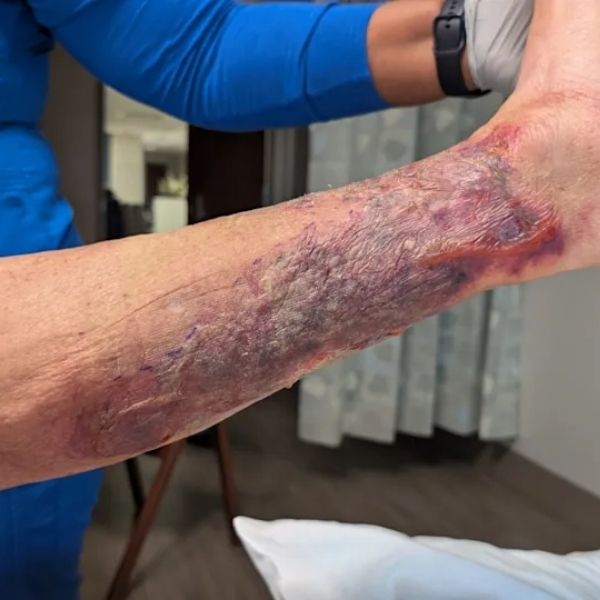The Florida Department of Health reported another case of Vibrio vulnificus, the dangerous infection known as “flesh-eating bacteria,” in a Thursday, Nov. 13 morning update.
The update confirmed the new case in Polk County, raising this year’s statewide total to 31.
Five people have died from Vibrio vulnificus so far this year. According to FDOH data, the deaths happened in Bay County, Broward County, Hillsborough County and St. John’s County.
Vibrio vulnificus is a bacterial infection found in warm, brackish seawater or floodwaters. People usually contract it by eating raw or undercooked seafood, especially raw oysters, but it can also enter the body through open cuts or wounds exposed to the water.
Infections are rare, but the consequences can be severe and sometimes deadly. Once the infection begins, the skin and soft tissue around the wound can rapidly deteriorate. In some cases, doctors may need to amputate a limb to stop the spread, even when treatment begins quickly.
How many people have died from flesh-eating bacteria in Florida?
FDOH reports five deaths in 2025 as of Thursday, Nov. 31:
Bay County: 2
Broward County: 1
Hillsborough County: 1
St. Johns County: 1
Between 2008 and 2025, Florida recorded 179 deaths from Vibrio vulnificus.
Louisiana has also seen a surge in cases this year. As of September 16, 26 people were hospitalized and five died, according to the state’s health department. Most cases involved wound or seawater exposure, and 24 of the 26 patients had at least one underlying health condition.
Two people died after eating raw oysters, said Jennifer Armentor, molluscan shellfish program administrator with the Louisiana Department of Health.
Over the past decade during the same time period, Louisiana averaged 10 cases and one death each year.
Where have flesh-eating bacteria cases been reported in Florida?
As of Thursday, Nov. 13, FDOH has reported 31 cases in 2025:
Bay County: 2
Broward County: 3
Citrus County: 1
Collier County: 2
Duval County: 1
Escambia County: 3
Flagler County: 1
Hernando County: 1
Hillsborough County: 2
Lee County: 3
Manatee County: 1
Martin County: 1
Okaloosa County: 1
Polk County: 1
St. Johns County: 2
Santa Rosa County: 2
Volusia County: 1
Walton County: 1
Washington County: 1
A Miami-Dade case appeared in FDOH records in September but no longer appears, and the agency has not explained the change.
FDOH does not list sources or exact dates, but one of this year’s Escambia County cases involved Genevieve Gallagher, a Pensacola woman who contracted the bacteria after swimming with her daughter in Santa Rosa Sound on July 27. Doctors removed much of the tissue from her left leg below the knee, and she remained intubated for nearly a week.
“They debrided my leg down to the bare meat,” Gallagher said from her hospital bed. “They took most of the muscle, almost down to the bone, basically. It went up almost to my knee, so it’s a pretty large amount, and it’s all the way around my leg.”
In East Naples, 88-year-old retired U.S. Coast Guard pilot Albert Allison became infected in August. He was hospitalized, treated with three antibiotics, and later moved to a rehabilitation center.
“I thought I was going to die,” he said about the intense pain. “It looks like I’m going to make it.”
What’s the record for Vibrio vulnificus cases in Florida?
Florida set a record with 82 cases and 19 deaths in 2024. Most occurred after widespread flooding caused by back-to-back storms, Hurricane Helene and Hurricane Milton. This year, the state has avoided such storms.
From 2014 to 2024, Florida averaged around 48 cases and 11 deaths annually. Excluding 2022 and 2024, when hurricanes boosted case numbers, the average is about 41 cases and 9 deaths per year.
Across the U.S., Vibrio vulnificus and other Vibrio infections cause an estimated 80,000 illnesses and 100 deaths annually, according to the CDC.
What is Vibrio vulnificus?
Vibrio vulnificus grows in warm brackish water, where freshwater mixes with seawater.
Although infections are uncommon, they can cause severe tissue damage, spreading blisters, dangerously low blood pressure, fever, organ failure, sepsis, and death. The bacteria is called “flesh-eating” because it can lead to necrotizing fasciitis, which destroys muscle and skin tissue. Without fast treatment, death can occur within days.
People with weakened immune systems, liver disease, or open wounds face a higher risk, FDOH warns.
What are the symptoms of Vibrio vulnificus?
Common symptoms include fever, chills, low blood pressure, stomach cramps, nausea, vomiting, blistering skin lesions, redness, swelling, warmth, discoloration, pain, and leaking fluids near an open wound, according to the CDC.
Symptoms usually appear suddenly within 24 hours of exposure.
If symptoms begin after eating raw seafood or contact with floodwaters, seek medical attention immediately. Doctors can treat the infection with antibiotics, but in severe cases, they may need to amputate infected limbs.
“Many people with Vibrio vulnificus infection require intensive care or limb amputations,” the CDC said, “and about 1 in 5 people with this infection die, sometimes within a day or two of becoming ill.”
How can I avoid contracting Vibrio vulnificus?
The FDOH and CDC recommend the following when eating seafood:
Do not eat raw oysters or other raw shellfish.
Eat shellfish immediately after cooking and refrigerate leftovers.
Cook shellfish thoroughly: boil in the shell until shells open and then boil for 5 more minutes, or steam until shells open and then steam for 9 more minutes. Boil shucked oysters for at least 3 minutes or fry them in oil at 375 degrees for at least 10 minutes. Do not eat shellfish that do not open.
Avoid cross-contamination between raw and cooked seafood. Wear gloves when handling raw shellfish.
If swimming:
Wear foot protection to reduce cuts from rocks and shells, especially if you are immunocompromised.
Avoid exposing open wounds to warm saltwater, brackish water, floodwater, or raw shellfish. Cover wounds with a waterproof bandage or stay out of the water.
Wash all cuts with soap and water immediately after contact with saltwater, raw seafood, or their juices.
Seek immediate medical care if a wound becomes red, swollen, painful, warm, or begins oozing, or if symptoms like fever, shortness of breath, fast heart rate, or confusion appear.
This article has been carefully fact-checked by our editorial team to ensure accuracy and eliminate any misleading information. We are committed to maintaining the highest standards of integrity in our content.
















Leave a Reply